The AMD Ryzen Threadripper 1950X and 1920X Review: CPUs on Steroids
by Ian Cutress on August 10, 2017 9:00 AM ESTCPU Legacy Tests
Our legacy tests represent benchmarks that were once at the height of their time. Some of these are industry standard synthetics, and we have data going back over 10 years. All of the data here has been rerun on Windows 10, and we plan to go back several generations of components to see how performance has evolved.
All of our benchmark results can also be found in our benchmark engine, Bench.
3D Particle Movement v1
3DPM is a self-penned benchmark, taking basic 3D movement algorithms used in Brownian Motion simulations and testing them for speed. High floating point performance, MHz and IPC wins in the single thread version, whereas the multithread version has to handle the threads and loves more cores. This is the original version, written in the style of a typical non-computer science student coding up an algorithm for their theoretical problem, and comes without any non-obvious optimizations not already performed by the compiler, such as false sharing.
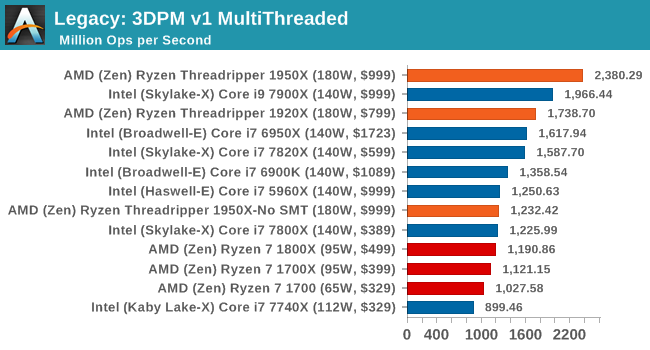
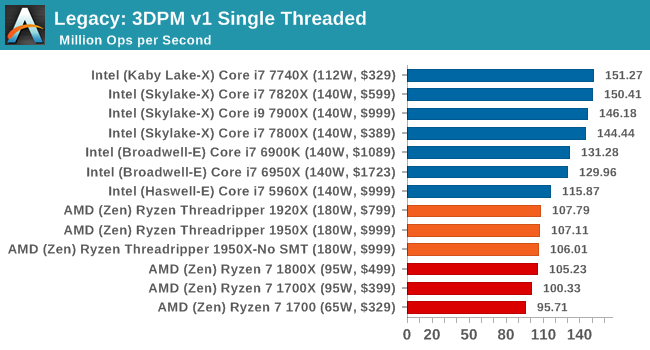
CineBench 11.5 and 10
Cinebench is a widely known benchmarking tool for measuring performance relative to MAXON's animation software Cinema 4D. Cinebench has been optimized over a decade and focuses on purely CPU horsepower, meaning if there is a discrepancy in pure throughput characteristics, Cinebench is likely to show that discrepancy. Arguably other software doesn't make use of all the tools available, so the real world relevance might purely be academic, but given our large database of data for Cinebench it seems difficult to ignore a small five minute test. We run the modern version 15 in this test, as well as the older 11.5 and 10 due to our back data.
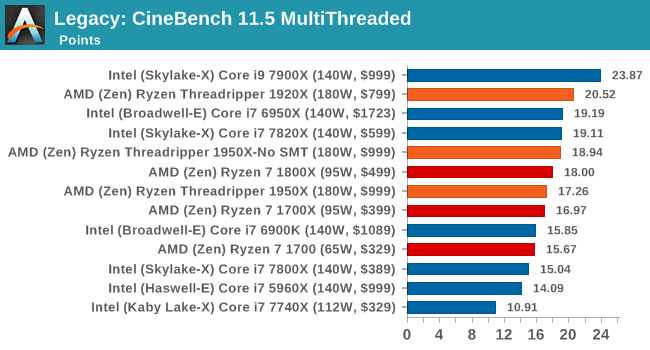
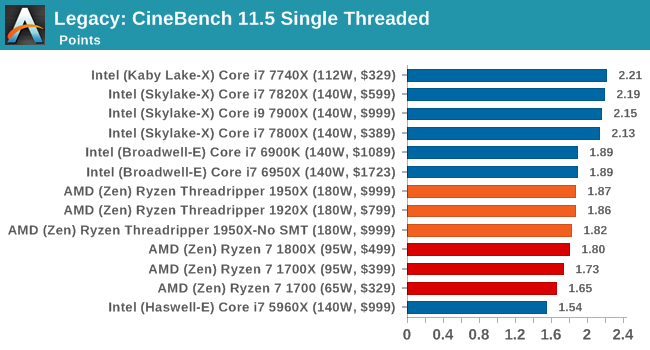
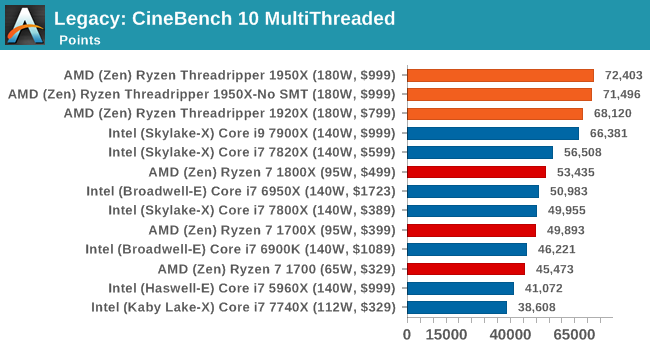
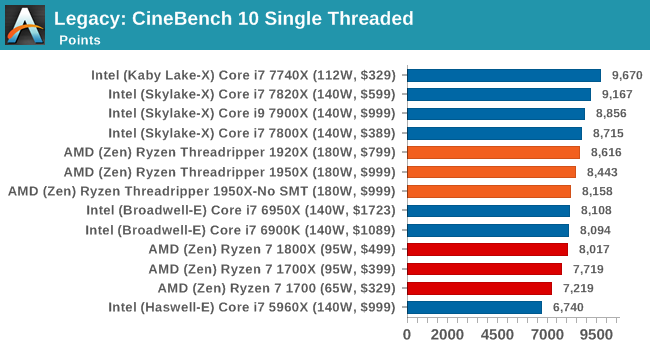
x264 HD 3.0
Similarly, the x264 HD 3.0 package we use here is also kept for historic regressional data. The latest version is 5.0.1, and encodes a 1080p video clip into a high-quality x264 file. Version 3.0 only performs the same test on a 720p file, and in most circumstances the software performance hits its limit on high-end processors, but still works well for mainstream and low-end. Also, this version only takes a few minutes, whereas the latest can take over 90 minutes to run.
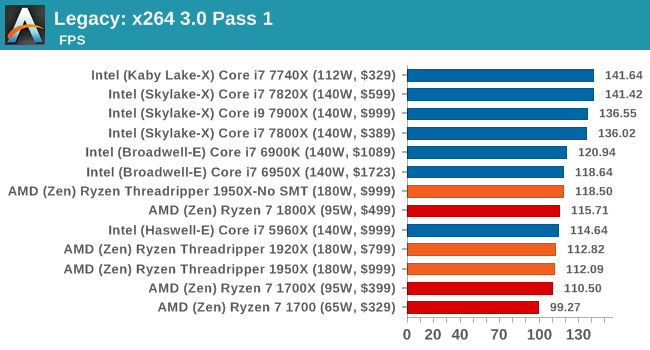
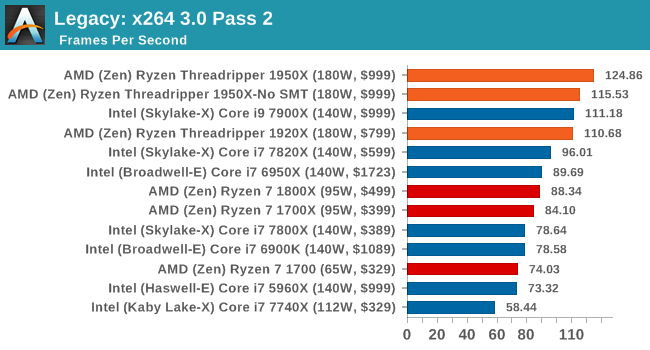
The 1950X: the first CPU to score higher on the 2nd pass of this test than it does on the first pass.










347 Comments
View All Comments
nitin213 - Thursday, August 10, 2017 - link
Thanks for your reply. Hopefully the test suite can be expanded as Intel's CPUs probably also move to higher core count and IO ranges in future.and i completely understand the frustration trying to get a 3rd party to change their defaults. Cheers
deathBOB - Thursday, August 10, 2017 - link
It's clear to me . . . Ian is playing both sides and making out like a bandit! /sFreckledTrout - Thursday, August 10, 2017 - link
Ian can we get an updated comments section so we can +/- people and after x number of minuses they wont show by default. I'm saying this because some of these comments(the one in this chain included) are not meaningful responces. The comments section is by far the weakest link on Anantech.Nice review btw.
mapesdhs - Thursday, August 10, 2017 - link
toms has that, indeed it's kinda handy for blanking out the trolls. Whether it's any useful indicator of "valid" opinion though, well, that kinda varies. :D (there's nowt to stop the trolls from voting everything under the sun, though one option would be to auto-suspend someone's ability to vote if their own posts get hidden from down voting too often, a hands-off way of slapping the trolls)Given the choice, I'd much rather just be able to *edit* what I've posted than up/down-vote what others have written. I still smile recalling a guy who posted a followup to apologise for the typos in his o.p., but the followup had typos aswell, after which he posted aaaaagh. :D
Ian.
Johan Steyn - Thursday, August 10, 2017 - link
Ian thanks for at least responding, I appreciate it. Please compare your review to sites like PCPer and many others. They have no problem to also point out the weak points of TR, yet clearly understand for what TR was mostly designed and focus properly on it and even though they did not test the 64 PCI lanes as an example, mention that they are planning a follow-up to do it, since it is an important point. You do mention these as well, but could have said more than just mention it by the way.Look at your review, most of it is about games. Are you serious?
I have to give you credit to at least mention the problems with Sysmark.
Let me give you an example of slanted journalism, When you do the rendering benchmarks, where AMD is known to shine, you only mention at each benchmark what they do etc, and fail to mention that AMD clearly beats Intel, even though other sites focus more ons these benchmarks. In the one benchmark where Intel get a descent score, you take time to mention that:
"Though it's interesting just how close the 10-core Core i9-7900X gets in the CPU (C++) test despite a significant core count disadvantage, likely due to a combination of higher IPC and clockspeeds."
Not in one of the rendering benchmarks do you give credit to AMD, yet you found it fitting to end the section of with:
"Intel recently announced that its new 18-core chip scores 3200 on Cinebench R15. That would be an extra 6.7% performance over the Threadripper 1950X for 2x the cost."
Not slanted journalism? At least you mention "2x the cost," but for most this will not defer them in buying the monopoly.
After focussing so much time on game performance, I am not sure you understand TR at all. AMD still has a long way to go in many areas. Why? Because corrupt Intel basically drove them to bankruptcy, but that is a discussion for another day. I lived through those days and experienced it myself.
Maybe I missed it, but where did you discuss the issue of memory speed? You mention in the beginning of memory overclock. Did you test the system running at 3200 or 2666? It is important to note. If you ran at 2666, then you are missing a very important point. Ryzen is known to gain a huge amount with memory speed. You should not regard 3200 as an overclock, since that is what that memory is made for, even if 2666 is standard spec. Most other sites I checked, used it like that. If you did use 3200, don't you think you should mention it?
Why is it that your review ends up meh about TR and leave you rather wanting an i9 an almost all respects, yet most of the other site gives admiration where deserved, even though they have criticism as well. Ian I see that you clearly are disappointed with TR, which is OK, maybe you just like playing games and that is why you are so.
It was clear how much you admire Intel in your previous article. You say that I gave no examples of slanted journalism, maybe you should read my post again. "Most Powerful, Most scalable." It is well known that people don't read the fine print. This was intentional. If not, you are a very unlucky guys for having so many unintended mishaps. Then I truly need to say I am sorry.
For once, please be a bit excited that there is some competition against the monopoly of Intel, or maybe you are also deluded that they became so without any underhanded ways.
By the way, sorry that I called you Anand. I actually wanted to type Anandtech, but left it like it. This site still carries his name and he should still take responsibility. After I posted, I realised I should have just checked the author, so sorry about that.
vanilla_gorilla - Thursday, August 10, 2017 - link
"Intel recently announced that its new 18-core chip scores 3200 on Cinebench R15. That would be an extra 6.7% performance over the Threadripper 1950X for 2x the cost."How do you not understand that is a dig at Intel? He's saying you have to pay twice as much for only a 6.7% improvement.
smilingcrow - Thursday, August 10, 2017 - link
The memory speed approach taken was clearly explained in the test and was stated as being consistent with how they always test.I don't take issue with testing at stock speeds at launch day as running memory out of spec for the system can be evaluated in depth later on.
Johan Steyn - Friday, August 11, 2017 - link
That is just rubbish. Threadripper has no problem with 3200 memory and other sites has no problem running it at that speed. 3200 memory is designed to run 3200, why run it at 2666? There is just no excuse except being paid by Intel.Maybe then you can accuse other sites of being unscientific?
fanofanand - Tuesday, August 15, 2017 - link
Anandtech always tests at JDEC, regardless of the brand.Manch - Friday, August 11, 2017 - link
""Intel recently announced that its new 18-core chip scores 3200 on Cinebench R15. That would be an extra 6.7% performance over the Threadripper 1950X for 2x the cost."Not slanted journalism? At least you mention "2x the cost," but for most this will not defer them in buying the monopoly."
You call Intel the monopoly and call him out for not wording the sentence to dissuade people from buying Intel. Who has the bias here? If he was actively promoting Intel over AMD or vice versa, you'd be OK with the latter, but to do neither. He's an Intel shill? Come on. That's unfair. HOW should he have wrote it so it would satisfy you?
FYI Anand is gone. He's NOT responsible for anything at Anandtech. Are you going to hold Wozniak's feet to the fire for the lack of ports on a Mac too?